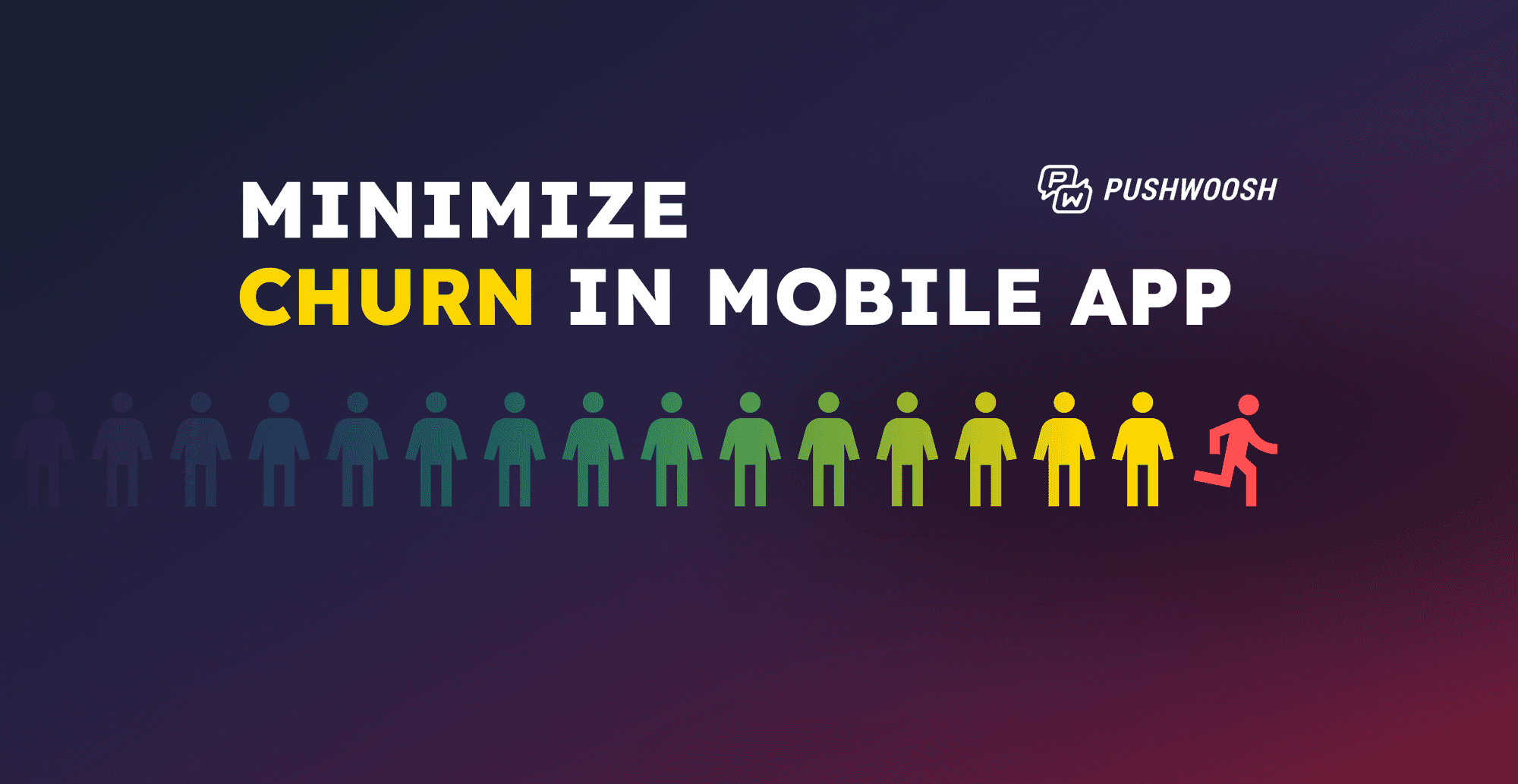How to increase app retention: Benchmarks & strategies for 2026
User retention is a topic for every marketer. Every time, all the time. And for a good reason, too! After all, we all know it’s not enough to capture customer attention once – instead, the real work begins with trying to get them to stay with your app and pass on the good word.
Whether you’re just starting to analyze your app retention or looking for ways to boost it, this guide will walk you through the latest app retention benchmarks, what a good retention rate looks like, and proven strategies to increase app retention in 2026. You can also jump to the industry app retention benchmarks section if you’re ready to compare your performance right away.
What is app retention (and why does it matter)?
What is app user retention?
User retention shows how many people stick around and keep using your app over time. It’s a lot like customer loyalty, too. Getting someone to download your app is the first step. But what really matters is whether they keep coming back and using it regularly.
High app retention shows that your app is valuable and engaging to its target audience. It means they find the app useful, fun, or beneficial enough to keep using it.
In mobile growth analytics, “app retention rate” is one of the core retention metrics used to measure long-term product value.
Retention curve explained
A user retention curve is a visual representation of retention over time. It shows how quickly users drop off after installing your app and when the retention rate begins to stabilize.
The flatter the curve, the better — it means users are sticking around instead of churning early. Sharp declines, on the other hand, often point to onboarding or activation issues. The retention curve is especially useful for cohort analysis, understanding D1/D7/D30 performance, and evaluating the long-term impact of your engagement and retention strategy.

Understanding your retention curve helps identify whether you’re meeting the “good” app retention rate benchmarks or losing users too early.
Why increasing app retention matters for app growth
User acquisition grabs attention. Retention builds momentum. Apps that fail to retain users in the first week lose over 80% of them — and that’s a steep price to pay when acquisition costs keep climbing.
App retention is a direct line to a higher lifetime value (LTV), lower churn, and sustainable growth. No matter your industry, keeping users engaged translates to stronger business performance.

How to calculate app retention rate (formula)
The most straightforward (and the most popular) approach is simply to divide the total number of MAUs by the total number of installs. As such, if 1000 people downloaded your app on Day 0, and you had 200 monthly active users in April, your user retention rate is 20%.
There is, however, a more insightful way to dig deeper into your app usage. At Pushwoosh, we use a different app retention rate formula that reveals more precise details about your customers’ behavior on a specific day.
App retention rate formula
To calculate app retention, take the percentage of users who opened the app on a given day (Day 1, Day 7, Day 30) and divide it by the number of users who installed the app on Day 0.
For example, let’s say you want to measure one-month retention. On July 1 (or any date at least 30 days ago), 1,000 users installed your app. Then, you check how many of them opened the app on July 30. If 350 users did, your retention rate for that period is:
350 ÷ 1,000 × 100% = 35%.
You can repeat this measurement for each month in a quarter or over the course of a year to track how your app’s user retention evolves over time.
What is a good app retention rate? (D1, D7, D30 benchmarks)
According to the Pushwoosh Benchmarks Study 2025, the average Day 7 retention rate on iOS is 6.89%, dropping to 3.10% by Day 30. For Android, the numbers are slightly lower: 5.15% on Day 7 and 2.82% on Day 30.
Of course, retention is influenced by a range of factors—app category, audience behavior, lifecycle stage, and how well brands engage users from day one. While these averages give us a pulse check, retention can vary widely. Leading apps in mature industries often outperform the norm, and some niche categories may naturally see steeper drop-offs.
So, what is a good retention rate for an app? The only way to answer that is to zoom on the specifics. Let’s break it down by industry to see where your app stands—and what benchmarks you should be aiming for.
Mobile app retention benchmarks 2025: Trends & insights
Overview
Across almost all categories, D1 retention rates are quite low, often falling below 20%. This indicates that users quickly lose interest or fail to find enough value in the app to continue beyond the first day. Driving immediate engagement through impactful onboarding and personalized experiences is crucial for extending user retention.
Another significant drop in retention occurs by Day 7 and becomes even more pronounced by Day 30, when many app categories retain less than 1% of their initial users. Such a steep decline suggests either a mismatch between the acquired audience and the app’s value proposition or ineffective user engagement and retention strategies.
Platform-specific insights (iOS vs Android app retention)
Generally, iOS apps retain users slightly better than Android apps do. The only exception is Telecommunications, where retention rates are higher on Android.
This may be attributed to platform-specific user behavior and expectations. If you’re deciding whether to invest in a native application or expand with a cross-platform product, analyzing retention trends across platforms can help refine your strategy.
Industry-specific insights
The highest D1 retention rates are observed in the News industry, with iOS leading at 35.88%.
It’s worth noting that Action Games have one of the highest retention rates among all apps on iOS, but the lowest on Android.
Have you compared your product against our mobile app retention benchmarks yet? Because we’re ready to dive even deeper with some evergreen strategies that will help you increase your CLV and drive more engagement than ever!
How to increase app retention: 9 proven strategies
If your goal is to keep users engaged during the first month and beyond, here are the core user retention strategies your app can adopt to retain users beyond Day 30 of their lifecycle.
#1. Guide users with proactive lifecycle notifications
Use push notifications strategically to reduce churn at predictable moments of drop-off (trial end, subscription renewal, or inactivity). These notifications must contain clear value — not just reminders — to avoid unsubscribes.
#2. Reinforce value early through strong onboarding
Focus your onboarding on helping users reach their “aha moment” quickly. A smooth, well-structured onboarding flow directly improves Day 1 and Day 7 retention.
What to highlight:
- Clear guidance
- Value upfront
- Early habit motivation
#3. Segment users based on behavior and personalize their experience
Use behavioral segmentation to deliver hyper-relevant messages and offers. The more tailored the experience, the higher the engagement and retention.
#4. Offer meaningful incentives at the right time
Provide incentives aligned with users’ lifecycle stage — not too early, not too late. Time-sensitive offers help reactivate high-churn-risk users without devaluing your product.
#5. Maintain high technical quality and provide supportive customer success
Fast performance, few bugs, and responsive support are retention fundamentals. Technical reliability is one of the strongest predictors of whether a user will continue using your app.
#6. Use in-app surveys to collect targeted feedback and improve the experience
Capture insights at critical moments (onboarding, feature use, checkout, inactivity).
Feedback reveals friction and helps product teams prioritize improvements that directly increase retention.
#7. Leverage habit-building mechanics and gamification
Introduce streaks, rewards, progress tracking, or milestone celebrations. These mechanisms train users to return and create emotional investment.
#8. Provide educational or supportive content that keeps users engaged
Support users with relevant content tailored to their needs — tutorials, resources, contextual tips, and educational materials help users stay active and invested.
#9. Nurture users with consistent communication across channels
Use omnichannel communication to reach users on their preferred channel. Consistent communication across touchpoints improves engagement, reactivation, and long-term retention.

Of course, the strategies you choose (and the way you apply them) will depend heavily on the industry you operate in. That’s why we gathered real examples from our customers’ campaigns and popular apps to show how some of the most in-demand niches stay connected with their audience and drive high app retention rates.
App retention strategies by industry (with examples)
E-Commerce & Retail
In e-commerce, where the competition is fierce, time is of the essence, and the best way to ensure you keep your audience engaged and grow customer retention is to reach them at the right moment. The second must-have component is a good incentive.
For example, you can throw in a free delivery for all the orders made through an app to entice customers into reactivating, like La Redoute did in the example below:
Another good way to leverage hyper-personalization for e-commerce and increase user retention is to appeal to customers’ previous shopping experience with dedicated product recommendations, similar to what SHEIN did here:
Finance & Banking
There are plenty of opportunities for mobile applications in the finance and banking industry to increase their user retention rates. The most important tip is to keep your clients’ interests high. Pun intended.
For example, you can take a page from Revolut’s book and engage your customers with better-personalized saving rates, like in this example:
Or you can appeal to innovators in your target audience and engage them with a promise of unique features they’d be the first to test, as long as they use your app frequently:
Gaming
As our report has shown, mobile game retention benchmarks drop significantly after the first day of use.
| iOS | Android | |||||
|---|---|---|---|---|---|---|
| D1 | D7 | D30 | D1 | D7 | D30 | |
| Action games | 21.48% | 5.81% | 2.53% | 1.11% | 0.16% | 0.04% |
| Hypercasual games | 24.52% | 12.14% | 7.34% | 23.68% | 9.00% | 4.30% |
This means it’s not enough to get a user to play your game. Instead, you need to establish a reward system that will encourage them to come back for more over and over again. Fortunately, there are plenty of opportunities for you to do just that!
For example, you can implement a system of daily rewards that encourage users to log in and play every day in order to unlock awesome prizes the longer they stay engaged, just like Candy Crush does:
Media & Entertainment
In the Media, Streaming, and Entertainment industries, you inevitably compete with behemoth brands like Netflix and Spotify. In fact, even those brands are endlessly competing against each other, barely maintaining their median monthly retention rate of around 2%.
That’s why, as in other industries, it’s essential to get to know your target audience and appeal to their unique acquired tastes. Here is a good example of how Spotify designs playlists “just for you” based on the tracks you’d listened to previously:

Subscription-based apps
User retention is particularly important for subscription-based services, as for them, it directly translates into paying customers. That’s why it should be one of your top priorities to have a retention strategy in place that drives engagement and consistency, and builds habits to ensure the user stays with your service for as long as possible.
Here is an example of an in-app message by Duolingo that encourages people to build up their language learning streaks consistently:
And here is another one by Ewa, setting an excellent example of how mobile push notifications with daily reminders help retain more customers:

What retention metrics to track
To improve retention, you must understand which metrics signal healthy user engagement and which highlight risk. Here are the core retention metrics every mobile team should measure:
D1 / D7 / D30 retention: These metrics show how well your onboarding, activation, and habit loops work.
- D1 retention → onboarding quality
- D7 retention → early value & activation
- D30 retention → long-term product fit
DAU, MAU: Daily and monthly active users help determine usage frequency and engagement depth.
Stickiness rate (DAU ÷ MAU): Shows how often monthly users return daily.
Higher stickiness = stronger habit loops.
Churn rate: The percentage of users who stop using your app. Tracking churn helps you identify where drop-offs happen in the journey.
LTV (Lifetime value) Measures revenue generated over the user lifecycle.
Higher retention = higher LTV.
Cohort retention: Analyzes retention by user cohort (e.g., install date or source). This helps identify which campaigns bring the most valuable users.
Time-to-value (TTV): How quickly users experience your app’s core benefit. Shorter TTV = better retention.
Increase your app retention with Pushwoosh
As you can see, communicating with the user is at the heart of each strategy. And one of the best ways to stay connected with your audience is through omnichannel mobile communications, sent in the form of push notifications, in-app messages, emails, or even SMS.
Pushwoosh can become your trusted partner in driving app retention and supporting you at every stage of your customers’ journey. Here is just a brief overview of how our automation solutions can help:
- Build lifecycle messaging campaigns that will run in the background of your marketing efforts;
- Set up trigger events that will send off relevant communications to help you engage more customers at the right moment and increase app retention;
- Analyze user behavior inside your app and identify those at risk of churn;
- Ensure personalized omnichannel experiences for your customers so that they receive transactional updates and relevant marketing communications across the channels of their choice.
Sounds exciting? Learn more about Pushwoosh on a personal demo:













